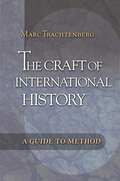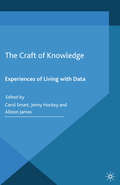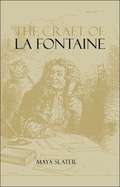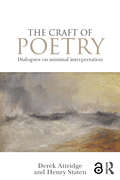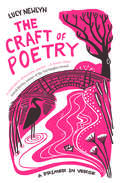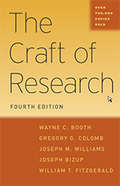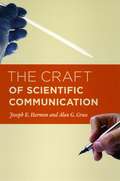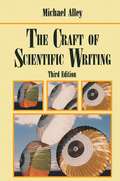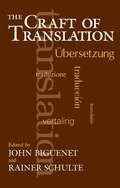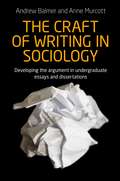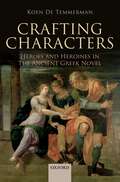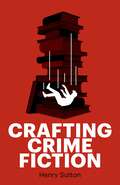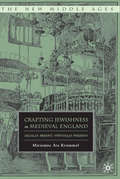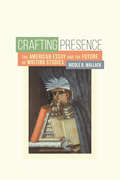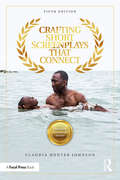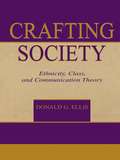- Table View
- List View
The Craft of International History: A Guide to Method
by Marc TrachtenbergThis is a practical guide to the historical study of international politics. The focus is on the nuts and bolts of historical research--that is, on how to use original sources, analyze and interpret historical works, and actually write a work of history. Two appendixes provide sources sure to be indispensable for anyone doing research in this area. The book does not simply lay down precepts. It presents examples drawn from the author's more than forty years' experience as a working historian. One important chapter, dealing with America's road to war in 1941, shows in unprecedented detail how an interpretation of a major historical issue can be developed. The aim throughout is to throw open the doors of the workshop so that young scholars, both historians and political scientists, can see the sort of thought processes the historian goes through before he or she puts anything on paper. Filled with valuable examples, this is a book anyone serious about conducting historical research will want to have on the bookshelf.
The Craft of Knowledge: Experiences of Living with Data
by Allison James Carol Smart Jenny HockeyThis book is a contribution to contemporary debates on social research with a unique focus on the relationship between methods and the crafting of knowledge. Nine experienced researchers from different disciplines have come together to explore what really matters to them in the process of doing qualitative research.
The Craft of LaFontaine
by Maya SlaterThis study provides a detailed account of the "Fables", including humour, the representation of animals, the literary qualities and the "moraliste" core. Dr Slater brings to light veiled satirical attacks, allusion to forgotten works and literature, and traces the obscure currents of thought, all this in the service of explicating the "fable" element.
The Craft of Poetry: Dialogues on Minimal Interpretation
by Derek Attridge Henry StatenThis book presents an innovative format for poetry criticism that its authors call "dialogical poetics." This approach shows that readings of poems, which in academic literary criticism often look like a product of settled knowledge, are in reality a continual negotiation between readers. But Derek Attridge and Henry Staten agree to rein in their own interpretive ingenuity and "minimally interpret" poems – reading them with careful regard for what the poem can be shown to actually say, in detail and as a whole, from opening to closure. Based on a series of emails, the book explores a number of topics in the reading of poetry, including historical and intellectual context, modernist difficulty, the role of criticism, and translation. This highly readable book will appeal to anyone who enjoys poetry, offering an inspiring resource for students whilst also mounting a challenge to some of the approaches to poetry currently widespread in the academy.
The Craft of Poetry: Dialogues on Minimal Interpretation
by Derek Attridge Henry StatenThis book presents an innovative format for poetry criticism that its authors call "dialogical poetics." This approach shows that readings of poems, which in academic literary criticism often look like a product of settled knowledge, are in reality a continual negotiation between readers. But Derek Attridge and Henry Staten agree to rein in their own interpretive ingenuity and "minimally interpret" poems – reading them with careful regard for what the poem can be shown to actually say, in detail and as a whole, from opening to closure. Based on a series of emails, the book explores a number of topics in the reading of poetry, including historical and intellectual context, modernist difficulty, the role of criticism, and translation. This highly readable book will appeal to anyone who enjoys poetry, offering an inspiring resource for students whilst also mounting a challenge to some of the approaches to poetry currently widespread in the academy.
The Craft of Poetry: A Primer in Verse
by Lucy NewlynA wonderfully accessible handbook to the art of writing and reading poetry—itself written entirely in verse How does poetry work? What should readers notice and look out for? Poet Lucy Newlyn demystifies the principles of the form, effortlessly illustrating key approaches and terms—all through her own original verse. Each poem exemplifies an aspect of poetic craft—but read together they suggest how poetry can evoke a whole community and its way of life in myriad ways. In a series of beautiful meditations, Newlyn guides the reader through key aspects of poetry, from sonnets and haiku to volta and synecdoche. Avoiding glosses and notes, her poems are allowed to speak for themselves, and show that there are no limits to what poetry can communicate. Newlyn’s timeless verse will appeal to lovers of poetry as well as to practitioners, teachers, and students of all ages.Onomatopoeia You’d play here all day if you had your way— near the stepping-stones, in the clearest of rock-pools, where water slaps and slips; where minnows dart, and a baby trout flop-flips.
The Craft of Research, Fourth Edition (Chicago Guides to Writing, Editing, and Publishing)
by Joseph M. Williams Wayne C. Booth Gregory G. Colomb Joseph Bizup William T. FitzGeraldWith more than three-quarters of a million copies sold since its first publication, The Craft of Research has helped generations of researchers at every level—from first-year undergraduates to advanced graduate students to research reporters in business and government—learn how to conduct effective and meaningful research. Conceived by seasoned researchers and educators Wayne C. Booth, Gregory G. Colomb, and Joseph M. Williams, this fundamental work explains how to find and evaluate sources, anticipate and respond to reader reservations, and integrate these pieces into an argument that stands up to reader critique. The fourth edition has been thoroughly but respectfully revised by Joseph Bizup and William T. FitzGerald. It retains the original five-part structure, as well as the sound advice of earlier editions, but reflects the way research and writing are taught and practiced today. Its chapters on finding and engaging sources now incorporate recent developments in library and Internet research, emphasizing new techniques made possible by online databases and search engines. Bizup and FitzGerald provide fresh examples and standardized terminology to clarify concepts like argument, warrant, and problem. Following the same guiding principle as earlier editions—that the skills of doing and reporting research are not just for elite students but for everyone—this new edition retains the accessible voice and direct approach that have made The Craft of Research a leader in the field of research reference. With updated examples and information on evaluation and using contemporary sources, this beloved classic is ready for the next generation of researchers.
The Craft of Scientific Communication (Chicago Guides to Writing, Editing, and Publishing)
by Joseph E. Harmon Alan G. GrossThe ability to communicate in print and person is essential to the life of a successful scientist. But since writing is often secondary in scientific education and teaching, there remains a significant need for guides that teach scientists how best to convey their research to general and professional audiences. The Craft of Scientific Communication will teach science students and scientists alike how to improve the clarity, cogency, and communicative power of their words and images. In this remarkable guide, Joseph E. Harmon and Alan G. Gross have combined their many years of experience in the art of science writing to analyze published examples of how the best scientists communicate. Organized topically with information on the structural elements and the style of scientific communications, each chapter draws on models of past successes and failures to show students and practitioners how best to negotiate the world of print, online publication, and oral presentation.
The Craft of Scientific Communication (Chicago Guides to Writing, Editing, and Publishing)
by Joseph E. Harmon Alan G. GrossThe ability to communicate in print and person is essential to the life of a successful scientist. But since writing is often secondary in scientific education and teaching, there remains a significant need for guides that teach scientists how best to convey their research to general and professional audiences. The Craft of Scientific Communication will teach science students and scientists alike how to improve the clarity, cogency, and communicative power of their words and images. In this remarkable guide, Joseph E. Harmon and Alan G. Gross have combined their many years of experience in the art of science writing to analyze published examples of how the best scientists communicate. Organized topically with information on the structural elements and the style of scientific communications, each chapter draws on models of past successes and failures to show students and practitioners how best to negotiate the world of print, online publication, and oral presentation.
The Craft of Scientific Communication (Chicago Guides to Writing, Editing, and Publishing)
by Joseph E. Harmon Alan G. GrossThe ability to communicate in print and person is essential to the life of a successful scientist. But since writing is often secondary in scientific education and teaching, there remains a significant need for guides that teach scientists how best to convey their research to general and professional audiences. The Craft of Scientific Communication will teach science students and scientists alike how to improve the clarity, cogency, and communicative power of their words and images. In this remarkable guide, Joseph E. Harmon and Alan G. Gross have combined their many years of experience in the art of science writing to analyze published examples of how the best scientists communicate. Organized topically with information on the structural elements and the style of scientific communications, each chapter draws on models of past successes and failures to show students and practitioners how best to negotiate the world of print, online publication, and oral presentation.
The Craft of Scientific Communication (Chicago Guides to Writing, Editing, and Publishing)
by Joseph E. Harmon Alan G. GrossThe ability to communicate in print and person is essential to the life of a successful scientist. But since writing is often secondary in scientific education and teaching, there remains a significant need for guides that teach scientists how best to convey their research to general and professional audiences. The Craft of Scientific Communication will teach science students and scientists alike how to improve the clarity, cogency, and communicative power of their words and images. In this remarkable guide, Joseph E. Harmon and Alan G. Gross have combined their many years of experience in the art of science writing to analyze published examples of how the best scientists communicate. Organized topically with information on the structural elements and the style of scientific communications, each chapter draws on models of past successes and failures to show students and practitioners how best to negotiate the world of print, online publication, and oral presentation.
The Craft of Scientific Communication (Chicago Guides to Writing, Editing, and Publishing)
by Joseph E. Harmon Alan G. GrossThe ability to communicate in print and person is essential to the life of a successful scientist. But since writing is often secondary in scientific education and teaching, there remains a significant need for guides that teach scientists how best to convey their research to general and professional audiences. The Craft of Scientific Communication will teach science students and scientists alike how to improve the clarity, cogency, and communicative power of their words and images. In this remarkable guide, Joseph E. Harmon and Alan G. Gross have combined their many years of experience in the art of science writing to analyze published examples of how the best scientists communicate. Organized topically with information on the structural elements and the style of scientific communications, each chapter draws on models of past successes and failures to show students and practitioners how best to negotiate the world of print, online publication, and oral presentation.
The Craft of Scientific Communication (Chicago Guides to Writing, Editing, and Publishing)
by Joseph E. Harmon Alan G. GrossThe ability to communicate in print and person is essential to the life of a successful scientist. But since writing is often secondary in scientific education and teaching, there remains a significant need for guides that teach scientists how best to convey their research to general and professional audiences. The Craft of Scientific Communication will teach science students and scientists alike how to improve the clarity, cogency, and communicative power of their words and images. In this remarkable guide, Joseph E. Harmon and Alan G. Gross have combined their many years of experience in the art of science writing to analyze published examples of how the best scientists communicate. Organized topically with information on the structural elements and the style of scientific communications, each chapter draws on models of past successes and failures to show students and practitioners how best to negotiate the world of print, online publication, and oral presentation.
The Craft of Scientific Writing
by Michael AlleyDesigned to help both professional and student scientists and engineers write clearly and effectively, this text approaches the subject in a fresh way. Using scores of examples from a wide variety of authors and disciplines, the author - himself a writer and physicist -- demonstrates the difference between strong and weak scientific writing, and how to convey ideas to the intended audience. In addition, he gives advice on how to start writing, and how to revise drafts, including many suggestions about approaching a wide variety of tasks - from laboratory reports to grant proposals, from internal communications to press releases - as well as a concise guide to appropriate style and usage.
The Craft of Translation (Chicago Guides to Writing, Editing, and Publishing)
by John Biguenet Rainer SchulteWritten by some of the most distinguished literary translators working in English today, these essays offer new and uncommon insights into the understanding and craft of translation. The contributors not only describe the complexity of translating literature but also suggest the implications of the act of translation for critics, scholars, teachers, and students. The demands of translation, according to these writers, require both comprehensive scholarship in preparing to translate a text and broad creativity in recreating the text in a new language. Translation, thus, becomes a model for the most exacting reading and the most serious scholarship. Some of the contributors lay bare the rigorous methods of literary translation in comparisons of various translations of the same piece; some discuss the problems of translating a specific passage; others speak about the lessons learned over the course of a career in translation. As these essays make clear, translators work in the space between languages and, in so doing, provide insights into the ways in which a culture makes the world verbal. Exemplary readers both of authors and of their individual works, the translators represented in this collection demonstrate that the methodologies derived from the art and craft of translation can serve as a model to revitalize the interpretation and understanding of literary works. Readers will find the opportunity to look over the shoulders of the translators gathered together in this volume an exciting and surprising experience. The act of translation emerges both as a powerful integration of linguistic, semantic, cultural, and historical thinking and as a valuable commentary on how we communicate both within a culture and from one culture to another.
The craft of writing in sociology: Developing the argument in undergraduate essays and dissertations
by Andrew Balmer Anne MurcottThis is an indispensable companion for students studying sociology and related disciplines, such as politics and human geography, as well as courses which draw upon sociological writing, such as nursing, social psychology or health studies. It demystifies the process of constructing coherent and powerful arguments, starting from an essay's opening paragraphs, building evidence and sequencing key points in the middle, through to pulling together a punchy conclusion. It gives a clear and helpful overview of the most important grammatical rules in English, and provides advice on how to solve common problems experienced in writing, including getting rid of waffle, overcoming writer's block and cutting an essay down to its required length. Using examples from essays written by sociology students at leading universities, the book shows what they have done well, what could be done better and how to improve their work using the techniques reviewed.
The craft of writing in sociology: Developing the argument in undergraduate essays and dissertations
by Anne Murcott Andrew BalmerAn essential guide to constructing coherent and powerful arguments, using real examples from student work and demonstrating, step-by-step, how to read critically, write the opening paragraphs of an essay, provide evidence in the middle and construct punchy conclusions.
Crafting Characters: Heroes And Heroines In The Ancient Greek Novel
by Koen De TemmermanThe oldest European novels were written in ancient Greek during the first few centuries of the Common Era. Despite the gold rush towards these novels in the last two decades and the resurgence of interest in representations of character in literary studies, and Classical studies in particular, no volume has yet been devoted to exploring character and characterization in the ancient Greek novels. This study analyses the characterization of the protagonists in the five extant, so-called 'ideal' Greek novels (those of Chariton, Xenophon of Ephesus, Achilles Tatius, Longus, and Heliodorus). De Temmerman offers close readings of techniques of characterization used in each novel and combines modern—mainly, but not exclusively, structuralist—narratology and ancient rhetoric. He argues that three conceptual couples central to ancient theory of character, typification/individuation, idealistic/realistic characterization, and static/dynamic character, construct character in these narratives more ambiguously, more elusively, and in more complex ways than has so far been realized. Throughout the different chapters, it also becomes clear how intimately presentations of character are intertwined with self-portrayal and performance of the self.
Crafting crime fiction
by Henry SuttonJohn le Carré said the best place to start a crime novel is as near to the end of the story as possible. But how do you know what the story is?As writers, we all have different experiences and skills to draw upon, and this book will help you identify the right beginning, middle and end for your own crime novel.Whether you are writing a police procedural or a psychological thriller, you will need to consider the basic elements of a gripping narrative. Within these pages, you'll learn to master the art of storytelling, from creating a compelling plot that keeps readers on the edge of their seats to choosing the perfect point of view to bring your characters to life. Dive into the depths of suspense, mystery, and surprise, as you unravel the intricacies of crafting a crime novel that captivates and entertains.This guide will help any new or experienced writer to navigate the writing journey, uncovering the core principles that will make your crime fiction truly exceptional.
Crafting crime fiction
by Henry SuttonJohn le Carré said the best place to start a crime novel is as near to the end of the story as possible. But how do you know what the story is?As writers, we all have different experiences and skills to draw upon, and this book will help you identify the right beginning, middle and end for your own crime novel.Whether you are writing a police procedural or a psychological thriller, you will need to consider the basic elements of a gripping narrative. Within these pages, you'll learn to master the art of storytelling, from creating a compelling plot that keeps readers on the edge of their seats to choosing the perfect point of view to bring your characters to life. Dive into the depths of suspense, mystery, and surprise, as you unravel the intricacies of crafting a crime novel that captivates and entertains.This guide will help any new or experienced writer to navigate the writing journey, uncovering the core principles that will make your crime fiction truly exceptional.
Crafting Jewishness in Medieval England: Legally Absent, Virtually Present (The New Middle Ages)
by M. KrummelMiriamne Ara Krummel challenges the accepted history of the English Middle Ages as a monolithic age of Christian faith. By cataloguing and explicating the complex depictions of semitisms to be found in medieval literature and material culture, this volume argues that Jews were always present in medieval England.
Crafting Presence: The American Essay and the Future of Writing Studies
by Nicole B. WallackEssays are central to students’ and teachers’ development as thinkers in their fields. In Crafting Presence, Nicole B. Wallack develops an approach to teaching writing with the literary essay that holds promise for writing students, as well as for achieving a sense of common purpose currently lacking among professionals in composition, creative writing, and literature. Wallack analyzes examples drawn primarily from volumes of The Best American Essays to illuminate the most important quality of the essay as a literary form: the writer’s “presence.” She demonstrates how accounting for presence provides a flexible and rigorous heuristic for reading the contexts, formal elements, and purposes of essays. Such readings can help students learn writing principles, practices, and skills for crafting myriad presences rather than a single voice. Crafting Presence holds serious implications for writing pedagogy by providing new methods to help teachers and students become more insightful and confident readers and writers of essays. At a time when liberal arts education faces significant challenges, this important contribution to literary studies, composition, and creative writing shows how an essay-centered curriculum empowers students to show up in the world as public thinkers who must shape the “knowledge economy” of the twenty-first century.
Crafting Short Screenplays That Connect
by Claudia Hunter JohnsonCrafting Short Screenplays That Connect, Fifth Edition, stands alone among screenwriting books by emphasizing that human connection, though often overlooked, is as essential to writing effective screenplays as conflict. This ground-breaking book will show you how to advance and deepen your screenwriting skills, increasing your ability to write richer, more resonant short screenplays that will connect with your audience. Award-winning writer and director Claudia Hunter Johnson teaches you the all-important basics of dramatic technique and guides you through the challenging craft of writing short screenplays with carefully focused exercises of increasing length and complexity. In completing these exercises and applying Johnson’s techniques and insights to your own work, you will learn how to think more deeply about the screenwriter’s purpose, craft effective patterns of human change, and strengthen your storytelling skills. This 20th Anniversary Edition features 11 short screenplays, including Academy Award winning Barry Jenkins' (Moonlight, If Beale Street Could Talk) luminous short film, My Josephine, and an accompanying companion website that features the completed films and additional screenplay examples. The book has also been expanded and updated to include two new award-winning screenplays Killer Kart and The Great Wall of Vicky Lynn. and a brand-new chapter exploring the use of genre in the short film. An absolute must-have resource for students of screenwriting.
Crafting Short Screenplays That Connect
by Claudia Hunter JohnsonCrafting Short Screenplays That Connect, Fifth Edition, stands alone among screenwriting books by emphasizing that human connection, though often overlooked, is as essential to writing effective screenplays as conflict. This ground-breaking book will show you how to advance and deepen your screenwriting skills, increasing your ability to write richer, more resonant short screenplays that will connect with your audience. Award-winning writer and director Claudia Hunter Johnson teaches you the all-important basics of dramatic technique and guides you through the challenging craft of writing short screenplays with carefully focused exercises of increasing length and complexity. In completing these exercises and applying Johnson’s techniques and insights to your own work, you will learn how to think more deeply about the screenwriter’s purpose, craft effective patterns of human change, and strengthen your storytelling skills. This 20th Anniversary Edition features 11 short screenplays, including Academy Award winning Barry Jenkins' (Moonlight, If Beale Street Could Talk) luminous short film, My Josephine, and an accompanying companion website that features the completed films and additional screenplay examples. The book has also been expanded and updated to include two new award-winning screenplays Killer Kart and The Great Wall of Vicky Lynn. and a brand-new chapter exploring the use of genre in the short film. An absolute must-have resource for students of screenwriting.
Crafting Society: Ethnicity, Class, and Communication Theory (Routledge Communication Series)
by Donald G. EllisThe study of communication, language, and discourse is at once simple, elegant, and complex. Each of these areas is informed by "micro" subjective experiences of individuals and the "macro" processes of a culture. Communication itself is thoroughly modern yet it seeks anchorage in the traditions of the humanities and social sciences. All of this creates a significant challenge. In this monograph, Ellis considers the study of communication as he discusses three key issues in communication theory: (1) the growing emphasis on meaning, (2) the importance of a mediated culture, and (3) the links between micro communication activities and macro social categories such as ethnicity and social class. In response to these three issues, this book deals with the way people use language and communication to construct their world; this world is not constructed purely but is influenced by attitudes, ideologies, and biases. In the modern world the medium of communication has an impact on consciousness and society, and Ellis shows how the media are responsible for some of the fault lines in society. The book also explores principles of medium theory and documents the impact of media on psychological and sociological phenomena. Finally, work of Goffman, Giddens, and Randall Collins is extended to show how micro communication behaviors are implicated in and by social conditions. ADDITIONAL COPY FOR MAILER Expanded features: * The chapters work out a logic connecting real communication patterns with the broad principles upon which societies are explored. Thus the title "Crafting" Society--the crafting is purposefully active to indicate the dynamic processes involved in creating what we call society. Society and culture have their roots and empirical bases in communication; that is, in the daily struggles of interaction. * Two chapters on two of the most important and controversial issues of the day--ethnicity and class. These two chapters are clear illustrations of the new theoretical principles discussed throughout the book. * A chapter on social class is very unique for a book devoted to communication processes. Communication theorists do not usually write about class, even though it is a highly symbolic process and rooted in communication patterns. Class is a difficult concept in America since so few people, other than sociologists, care to talk about it. * A chapter on medium theory takes the bold step of experimenting a little by summarizing basic causal statements and propositions. This device underscores the goal of a theory which is to come to grips with testable statements. The focus is on medium theory and how the media influence consciousness and social structure. * A unique chapter takes up the issue of how communication processes are constitutive of social structures. It draws on work by Giddens and others to return to a concept of structure based on actions that produce and reproduce structure.
